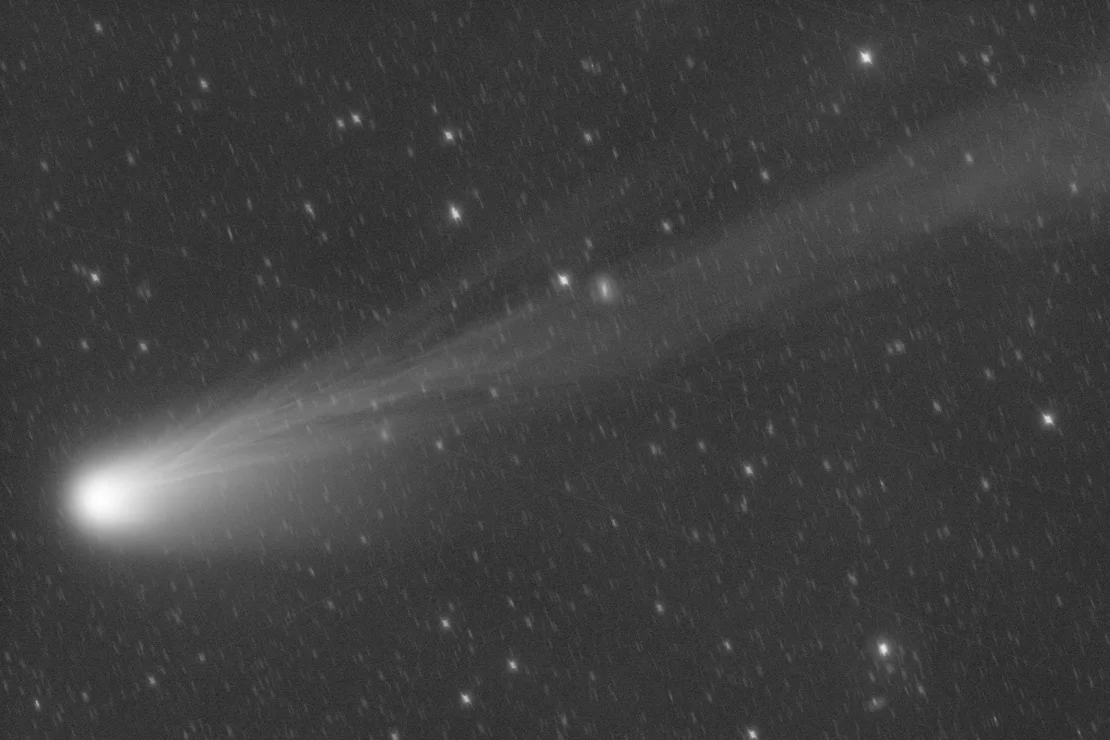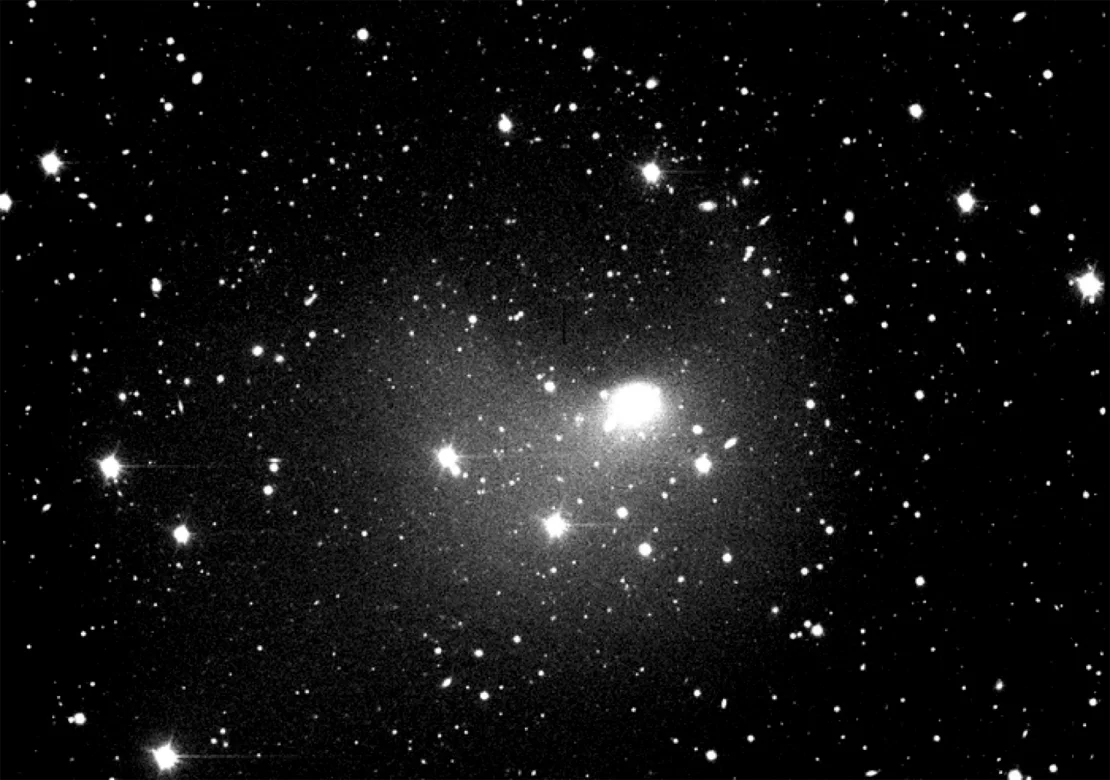(CNN) — An unusual horned comet, known for its series of explosions and nicknamed “Devil’s Comet,” will approach Earth on Sunday around 3 a.m. ET.
While the comet has not been visible to those in the Northern Hemisphere since the first week of May, sky watchers in the Southern Hemisphere have a better chance of catching a glimpse of the mysterious object through binoculars or a telescope.
Why a dynamic comet takes on the shape that has sparked comparisons with the Millennium Falcon spacecraft from the “Star Wars” movies when it is explosively active remains a mystery to scientists. But the celestial body only completes one orbit around the sun every 71 years, similar to Halley’s Comet, making the chances of observing it up close a once-in-a-lifetime opportunity.
Since the comet will not pass Earth again for decades, astronomers’ collective observations could provide key information about its true nature and behavior.
The celestial body, officially known as Comet 12P/Pons-Brooks, made its closest approach to the Sun on April 21, coming within 119.7 million kilometers (74.4 million miles) of our star.
The comet will reach its closest point to Earth on Sunday, but it will be more than 230 million kilometers away from our planet and will not pose any danger. For reference, the Sun is 149 million kilometers (93 million miles) away from Earth.

The Virtual Telescope Project captured a view of the comet above Manciano, in the Italian region of Tuscany, under the dark skies of the peninsula. Gianluca Masi/Virtual Telescope Project
The comet’s brightness peaked in late April and has been steadily fading for three to four weeks, said Dr. Dave Schleicher, an astronomer at Lowell Observatory in Arizona.
“For people below the equator, the coming weeks and months may be their first good chance to see this since the 1950s,” said astronomer Dr. Teddy Carretta, a postdoctoral fellow at Lowell University.
Two prolific discoverers, Jean-Louis Pons and William Robert Brooks, independently observed Comet Diablo: Pons in 1812 and Brooks in 1883. But it is likely that the comet made many trips around the Sun over thousands of years, long before it was believed Astronomers believe that comets are nothing else. “From something strange in the atmosphere,” Schleicher said.
Caretta said that astronomers estimate that the diameter of the massive comet ranges between 10 and 20 kilometers (6.2 and 12.4 miles).
The rare visitor has a green appearance typical of most comets because it contains diatomic carbon molecules that absorb sunlight and emit a color that appears green from our perspective, Schleicher said.
A series of cosmic explosions
Pons Brooks recently caught the attention of astronomers after it exhibited an interesting behavior that caused the comet to develop a horned appearance and soar across our solar system.
The comet has witnessed a series of explosions over the past eight months, expelling gas and dust. While such releases are not uncommon in comets, and a crescent or Pac-Man shape has been observed in other comets, it is difficult to determine what is normal for Pons Brooks.
“I would say it’s unusual because of the number of tantrums he had,” Schleicher said. “On the other hand, it’s not like you have good records from the past that allow you to know what’s really typical. And I suspect that given the large number of seizures that have occurred in the past eight months, this is clearly a regular occurrence for Pons Brooks.”
Comets are pieces of dust, rock, and ice, essentially frozen remains from the formation of the solar system. They also contain freezing elements such as carbon dioxide and carbon monoxide.
Comets become hotter and brighter as they approach the sun, Schleicher said, and some of the frozen gases stored in comets do not need to be heated much before they begin to turn into vapor.

The expanding bright spot (center) is an outburst from comet 12P/Pons-Brooks that occurred a day before the Lowell Discovery Telescope in Arizona captured this image in October 2023.
“We think the decisive factor, of course, is the temperature rise caused by the sun,” he said. “The comet is approaching. They have been frozen for years. “The heat will make its way from the surface to wherever there is carbon dioxide or carbon monoxide ice.”
Astronomers suspect that the Pons-Brooks explosions occurred over recurring events, in which heat vaporizes material inside the comet, causing pressure to build up and breach the surface. Although the gas explosion won’t be visible with telescopes, the dust it kicks off will create the kind of events observed from Ponce Brooks, Schleicher said.
Scientists traced jets of material observed shooting from the comet as it exploded to two source regions on its surface. Astronomers wonder why “the entire surface doesn’t explode like crazy,” Schleicher said.
Observations suggest that ice has formed over most of the surface, or that the ice has evaporated, leaving only dirt, but astronomers are “not entirely sure which of these mechanisms controls the display,” he said.
However, the comet’s explosions appear to have stopped and no activity has been seen since February, Caretta said.
What we can learn from comets
Astronomers have been observing Pons Brooks in hopes of discovering more details about its rotation velocity, or the speed at which comets rotate as they move through space. Pons Brooks’ rotation period is 57 hours, which is longer than expected, and astronomers want to know whether the jets of material ejected by the comet are accelerating or slowing down.
A series of overlapping events likely contributed to Ponce Brookes’ distinctive appearance, but it could also be due to our view of the comet, Carretta said.
“These are three-dimensional objects,” Caretta said. “When we take pictures of the night sky, we take them in a limited range of colors, all flat in two dimensions. “This will make things that might be very meaningful to you, if you were able to walk around and see them from two different perspectives, seem more complex than they really are. “






More Stories
The final moments of the “Halloween Comet” were captured by the SOHO spacecraft
University of Michigan scientists have discovered what’s inside a black hole
NASA shares the scariest images of the sun in the lead-up to Halloween